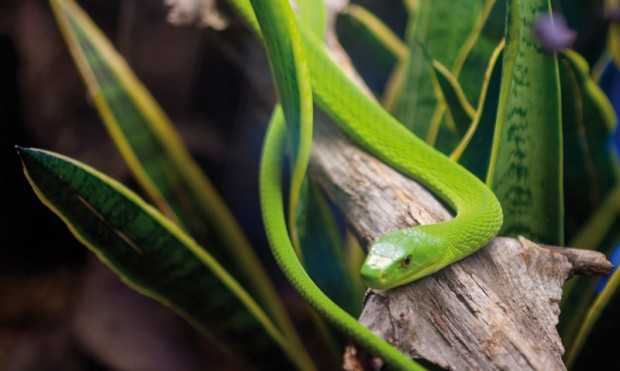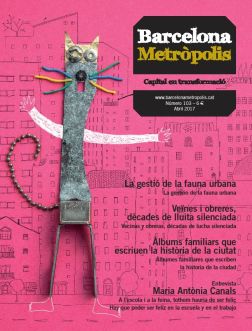Exotic animals are on the wrong end of either strong aversion or offensive greed from humans. But they suffer even more on account of their lack of recognition as vulnerable creatures and because they have nowhere they can call home.

A green mamba at the “Enverinats” (Poisonous) exhibition, which was shown at the Blau Museum from December 2013 to April 2015. The mamba is a species of snake that lives in trees, is extremely poisonous and can outpace humans at speed.
Photo: J.M. de Llobet / Natural Sciences Museum of Barcelona
They say that time puts everything in its rightful place, although the person who said it overlooked the human element. Barcelona, the city that adopted me eighteen years ago, is the ideal place only for those of us who like to be able to go out for a quiet walk; no-one sees you even if they look at you.
I have been working in animal protection for twenty-two years, more specifically with animals for which humans feel a strong aversion or an offensive degree of greed. But what they really suffer from is their lack of recognition as vulnerable creatures, which is why they also suffer from not having anywhere they can call home, when time is not afforded the luxury of putting everything in its rightful place. We call them exotic pets.
Barcelona is a cosmopolitan city, where purchasing power is high, and has always been a gateway for some bizarre whims. Not many years ago you could walk along the famous Rambla and be horrified or mesmerised by the variety of exotic animals worthy of a Thai market. I still believe that with a store front like that it is no surprise that this city has the problem it does: an uncontrolled trade in animals that are hard to understand and even harder to keep.
To the people who still think that the issue of exotic pets is a minor one and is nothing to get so het up about, I would simply refer them to the Law and say that there has been a Royal Decree on invasive fauna since 2011. We must remember that royal decrees are like fast-tracked laws to be enforced immediately. More specifically, this decree was enacted to put an end to exotic pets that are systematically abandoned because of a cruel trade and have adapted to the natural environment with all the terrible consequences that this entails and for which our city is unprepared. The law that confirms the chaos theory.
I cannot overstate this idea of cruel trade, in a world in which legality and morality do not always go hand in hand, and in which our neighbour can buy a four-metre-long snake that weighs in at 45 kilos and then abandon it without anyone being able to do anything about it. Because, although there is a legal framework governing the ownership of potentially dangerous dogs, the ownership of truly dangerous animals has never been regulated, so we end up finding caimans in Collserola that are not microchipped, or an Indian python in the middle of the street and clueless as to who had left it there. If they proliferate, they are bound to be blacklisted, as we collectively revert to the bad old days of putting healthy pets down.

A group of students observe a turtle in the garden of the Botanical Institute of Barcelona (IBB), in Montjuïc, during BioBlitzBcn 2016. This activity consists of identifying as many species as possible in the surrounding area.
Photo: J.M. de Llobet / Natural Sciences Museum of Barcelona
So the issue of exotic pets has indeed become a problem to get het up about. Firstly, we have the general abandonment of animals that have nowhere to go because, although the trade is legal, the ethical framework of how to address people’s irresponsibility has never been properly defined. Where will we put all the rabbits that end up in our parks and gardens? And then there is the problem of the invasion of the natural environment: there is no real control over this and we kid ourselves that if we return to the dark days of catching and killing we will get on top of the situation. I will not dwell on the cruelty meted to animals that never even asked to come here: we can save that for more private conversations. And regarding the issue of the lack of health controls to attend to the ever-growing demand for these kinds of animals, unfortunately such services are confined to highly technical spheres and only surface in cases of public health alerts. Hence, most of the population is misinformed and therefore vulnerable to diseases brought by exotic animals.
Faced with this exotic apocalypse, if we do not let Father Time sort things out, leaving him with egg on his face, what are we to do? How can we control these animals? The answer is easy. Follow their example: observe, come together and copy. Take the laws that were enacted to protect some animals and apply them to the others. Identify them, take a census, set up all-inclusive homes for abandoned animals…; all the things we once did for just two species – cats and dogs – but which we should also have done for the 400-plus species that we have made our pets. Put an end to the top hat syndrome – pulling a rabbit out of a hat and then using sleight of hand so that no one wonders where the animal went during the magic show –; realise our personal and institutional limitations and put a stop to a trade that brings no benefits. We need to remember the oft-reported economic losses caused by invasive species, animals brought here on a one-way trip.



